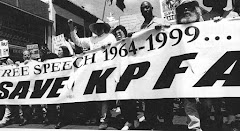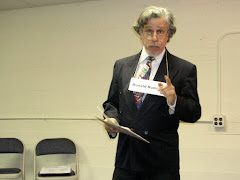"Well-constructed, action-flooded
sci-fi set in a realistic historical world." - Kirkus Reviews
This is an excerpt from Greg Guma's novel, Dons of Time, available from Fomite Press, Amazon, and Barnes & Noble. To read the conclusion, Enemy 2
Emerging from the airport baggage
claim late the following afternoon he crossed to the taxi stand for a lift into
town. It would be only minutes to the Hilton and a comfortable room with a
commanding view of the waterfront and Lake Champlain. But then he heard his
last name being called and noticed a wiry-haired kid holding a cardboard sign
with the word “Wolf” on it.
“I’m Wolfe,” he said, “Tonio, or
T. You here for me?”
“I guess so,” the kid shrugged,
“this way.” He grabbed Tonio’s bag without asking and led him into the parking
garage, boarding the elevator for the top. When they emerged and Tonio saw the
vehicle, a faded blue cargo van more than two decades old, he began to suspect
he’d made a mistake. Before he could do anything, the side door slid open and
three more young guys with scarves over their faces invited him inside.
“I hope you’re with Harry.”
Rather than answer they handed
him a scarf and asked him to blindfold himself. “Just for now,” one of them
apologized. These definitely weren’t Shelley’s people; their greeting would not
have been so civil. The government was also out. It didn’t use rusty vans or
operatives who dressed like hippie Zapatistas. This had to be Harry. Still, why
the drama? Despite his explanation over the phone it didn’t compute.
The ride took two hours, at first
on paved streets and the Interstate, then on local roads, and several minutes
at the end over rough gravel and dirt. When the van finally rolled to a stop
and it was time to remove the blindfold, he could have been anywhere from the
Canadian border to New Hampshire.
Harry was waiting at the cabin
door. He had always enjoyed costumes and preferred facial hair. This day he
looked like a cross between a pirate and a panda. “You have questions, I know,”
he announced. “Thanks for coming.”
“It better be good.” Tonio shook
his hand and followed.
The cabin was larger and more
functional than it looked from the driveway, part tech center, part mountain
retreat. Computer terminals covered one wall, screens running data, charts, and
video streams. Three college-age hackers monitored them. The rest of the main
room was taken up by a large oak table, several couches and thrift shop chairs,
a hard-working woodstove, all facing several unmarked doorways and an archway
that opened onto the communal kitchen.
Harry flopped down in a ratty lounge
chair, and said, “It was necessary, believe me. Not on my end, in this case. We
have good reasons to play it safe with you, my friend. You may already be a
person of interest.”
“That’s extreme,” Tonio objected,
“but I do believe Shelley had a tail on me.”
“That’s not what worries me.” He
pointed up with a finger, as far as Tonio knew meaning either God or spy satellites.
“What does worry you? More to the
point, what’s happened to you, man? Last I knew you were a radio personality.”
“A personality, right, I remember
when I had one of those,” Harry mused. “Last time I saw you we were about to
take over Seattle, right? Blocking the WTO, now that was a demo. Things looked
promising in ‘99, didn’t they? Even
after the coup – that’s what I call W’s first term – we totally derailed that
FTAA deal in Quebec. But they were already starting the crackdown. After the
attacks…well, you know that story, Patriot Act, wiretapping, secret searches,
the whole deal. Plus, for the first time the CIA gets a direct role in deciding
who gets rounded up or hit. It was the first stages of drone justice.”
That still didn’t explain why he
was hiding in the woods, and Harry knew it.
“I was operating above ground
then,” he reminisced. “But things were changing. It was an eavesdropping
bonanza. The intelligence budget hit $60 billion after 9/11 and thousands of new
private contractors got into the game. It was a very lucrative club in a very
growing industry. And Fort Meade, that was the Gold Rush zone for masters of
the data stream.
“I still had the show then. But
instead of the usual stuff I started talking about the surveillance state, what
the government was really up to. Big mistake as it turns out. In 2007 I tried
to board a flight to DC and found out I was on a no-fly list.” After more than
an hour of interrogation Harry was released. But not his laptop, cell phone,
camera and USB drive.
As Harry outlined the rest of his
path from radio host to underground man Tonio heard more than he wanted about
Crystal City and the Wiretappers’s Ball, a secret annual gathering where
experts shared their latest toys and competed to create the ultimate bugging
device. Harry had managed to infiltrate it and bring out pictures. He also
talked on the air about Verint Systems and Narus, major private eavesdropping
operations that reached most of the planet. They made it easier to block
websites considered politically or culturally threatening to those in power.
The next flashpoint for Harry
came after the Democrats capitulated on amendments to the Foreign Intelligence
Surveillance Act. He explained that the changes gave the telecoms legal
immunity while providing a go-ahead for the NSA to target almost anyone
classified as a terrorist. Obama, who was running for President at the time,
opted to support the amendments. Once he was in office, the move toward mass
surveillance launched almost a decade earlier continued to escalate. Obama’s
Justice Department invoked “state secrets” to stop citizens from suing the
government for spying on them. In fact, it argued that the feds had immunity
from litigation for any surveillance that violated the law.
“You thought I was being ridiculous
about emails, right?” Harry reminded him. “There’s a reason, Sherlock, the CIA.
They’ve invested heavily in Visible Technologies, which analyzes social media.
It can look into half a million websites a day. But the biggest reason we’re
here, instead of enjoying room service on your tab, is because in 2010 they
demanded all the visitor information from Truthsquad. I mean everything, and we
weren’t supposed to tell anyone about it under penalty of prosecution for
impeding a federal investigation.
“The IFC – that’s the Internet
Freedom Center – challenged the subpoena.” He was winding down. “But it was obvious
where this was heading. They’d already jailed Bradley Manning for the Wikileaks
cables and Julian was under house arrest. The handwriting was on the wall. It
was only a matter of time ‘til that knock on the door and I’m a suspected
cyber-terrorist. That was two years ago, shortly before we set up here. Just in
time it turns out, since now I’m on the terrorist screening database. Drone
bait -- if they ever find me outside the country.”
“But we’re safe and secure?”
“Like a frog’s ass, baby.
Acoustic dampening, the latest in encryption. We just added self-destructing
e-mails and encrypted cell phone calls, anything you send digitally. By next
year there will be a commercial self-destruct app on the market, but ours is better.
My rule of thumb is either that the message is destroyed after it’s read, or
else no more than an hour or two after sending it goes poof, like Mission
Impossible. But your current security, not so great.”
Considering what he had just
heard Tonio wasn’t surprised Harry felt that way.
Stay in touch for the conclusion of this chapter. Like Dons of Time on Facebook.









































